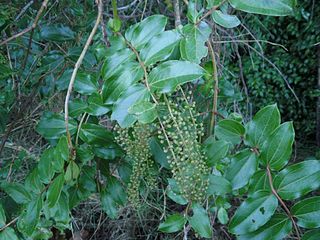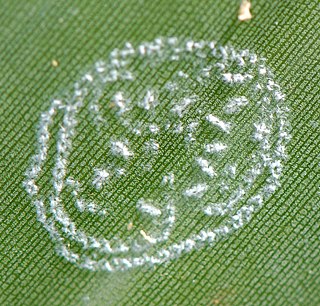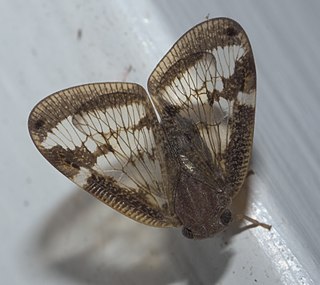
Hemiptera is an order of insects, commonly called true bugs, comprising over 80,000 species within groups such as the cicadas, aphids, planthoppers, leafhoppers, assassin bugs, bed bugs, and shield bugs. They range in size from 1 mm (0.04 in) to around 15 cm (6 in), and share a common arrangement of piercing-sucking mouthparts. The name "true bugs" is often limited to the suborder Heteroptera.

Tutu is a common name of Māori origin for plants in the genus Coriaria found in New Zealand.

Treehoppers and thorn bugs are members of the family Membracidae, a group of insects related to the cicadas and the leafhoppers. About 3,200 species of treehoppers in over 400 genera are known. They are found on all continents except Antarctica; only five species are known from Europe. Individual treehoppers usually live for only a few months.

Honeydew is a sugar-rich sticky liquid, secreted by aphids, some scale insects, and many other true bugs and some other insects as they feed on plant sap. When their mouthpart penetrates the phloem, the sugary, high-pressure liquid is forced out of the anus of the insects, allowing them to rapidly process the large volume of sap required to extract essential nutrients present at low concentrations. Honeydew is particularly common as a secretion in hemipteran insects and is often the basis for trophobiosis. Some caterpillars of Lycaenidae butterflies and some moths also produce honeydew. In addition to various sugars, honeydew contains small amounts of amino acids, other organic compounds, and inorganic salts with its precise makeup affected by factors such as insect species, host plant species, and whether a symbiotic organism is present.

A planthopper is any insect in the infraorder Fulgoromorpha, in the suborder Auchenorrhyncha, a group exceeding 12,500 described species worldwide. The name comes from their remarkable resemblance to leaves and other plants of their environment and that they often "hop" for quick transportation in a similar way to that of grasshoppers. However, planthoppers generally walk very slowly. Distributed worldwide, all members of this group are plant-feeders, though few are considered pests. The infraorder contains only a single superfamily, Fulgoroidea. Fulgoroids are most reliably distinguished from the other Auchenorrhyncha by two features; the bifurcate (Y-shaped) anal vein in the forewing, and the thickened, three-segmented antennae, with a generally round or egg-shaped second segment (pedicel) that bears a fine filamentous arista.

Eurybrachidae is a small family of planthoppers with species occurring in parts of Asia, Australia and Africa. They are remarkable for the sophistication of their automimicry.

Pseudococcus viburni is a close relative of the grape mealybug and a pest of the vineyards around the world.

Beekeeping in New Zealand is reported to have commenced in 1839 with the importing of two skep hives by Mary Bumby, a missionary. It has since become an established industry as well a hobby activity.

Tutin is a poisonous plant derivative found in New Zealand tutu plants. It acts as a potent antagonist of the glycine receptor, and has powerful convulsant effects. It is used in scientific research into the glycine receptor. It is sometimes associated with outbreaks of toxic honey poisoning when bees feed on honeydew exudate from the sap-sucking passion vine hopper insect, when the vine hoppers have been feeding on the sap of tutu bushes. Toxic honey is a rare event and is more likely to occur when comb honey is eaten directly from a hive that has been harvesting honeydew from passionvine hoppers feeding on tutu plants.

Cryptolaemus montrouzieri, common name mealybug ladybird or mealybug destroyer, is a species of ladybird beetle native to eastern Australia. The beetle feeds on mealybugs and other scale insects, and is used to control those pests on citrus orchards worldwide.

Pheidole megacephala is a species of ant in the family Formicidae. It is commonly known as the big-headed ant in the US and the coastal brown ant in Australia. It is a very successful invasive species and is considered a danger to native ants in Australia and other places. It is regarded as one of the world's worst invasive ant species.

Coccus viridis is a soft scale insect in the family Coccidae with a wide host range. It is commonly known as green scale or sometimes coffee green scale because it is a major pest of coffee crops throughout the world.

Metcalfa pruinosa, the citrus flatid planthopper, is a species of insect in the Flatidae family of planthoppers first described by Thomas Say in 1830.

Coriaria arborea is a highly poisonous and common native shrub or small tree of New Zealand. The common name for this and the other New Zealand species of Coriaria is tutu.

Aleurodicus dispersus, the spiralling whitefly, is a species of small, white sap-sucking insect, a true bug in the order Hemiptera. It originated in Central America and the Caribbean region and has spread to many of the world's tropical and subtropical regions, where it has become a major pest of agricultural crops.

The spotted lanternfly is a planthopper indigenous to parts of China and Vietnam. It has spread invasively to Japan, South Korea, and the United States. Its preferred host is tree of heaven, but it infests crops including soybean, grapes, stone fruits, and Malus spp. In its native habitat, L. delicatula populations are regulated by parasitic wasps.
Pyrilla perpusilla, commonly known as the sugarcane planthopper, is a planthopper in the family Lophopidae. It is native to Asia where it feeds on grasses and other plants and is a major pest of sugarcane and sorghum.

Scolypopa is a genus of planthoppers in the family Ricaniidae. There are about eight described species in Scolypopa, found mainly in Australia and New Zealand.

Lycorma imperialis is a planthopper indigenous to parts of China and Indo-Malaysia. L. imperialis was originally discovered in 1846 by Adam White and has one recognized non-nominate subspecies, L. i. punicea. L. imperialis has undergone a number of reclassifications since its discovery and is one of four species in the genus Lycorma. L. imperialis follows a hemimetabolous life cycle and will undergo a series of nymphal stages (instars) before maturing to an adult.

Orchamoplatus citri, commonly known as the Australian citrus whitefly, is a whitefly species in the genus Orchamoplatus. It is found across Australia and New Zealand, primarily foraging on the leaves of citrus trees.
























